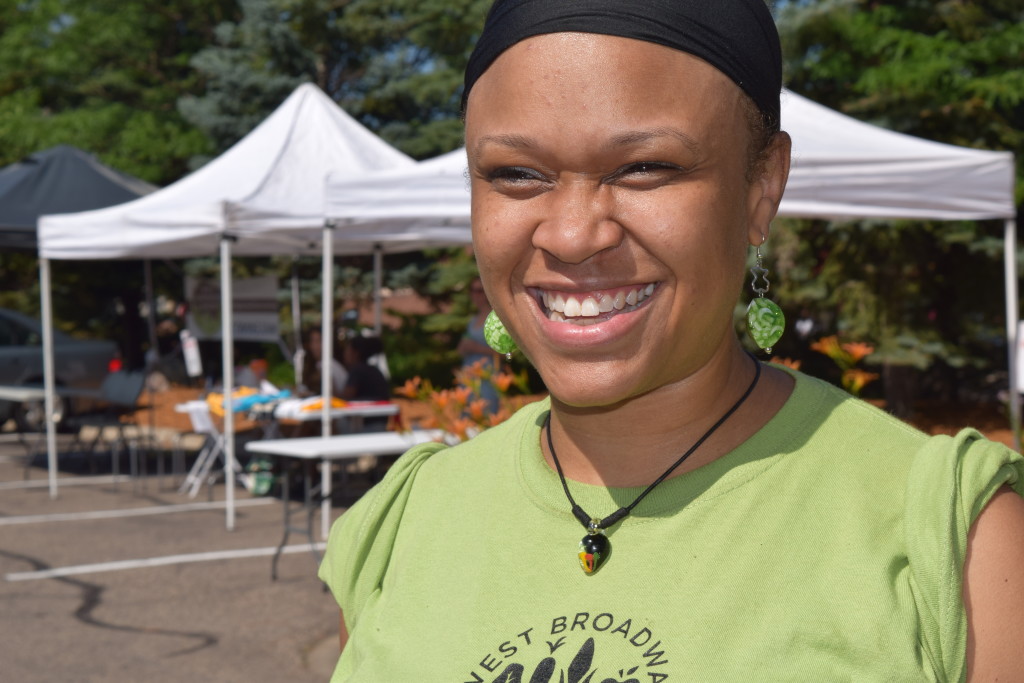
DeVon Nolen is on a mission — to improve the health of north Minneapolis residents.
It’s a Friday afternoon at the West Broadway Farmers Market, and Nolen, the market manager, is using her bullhorn. “EBT SNAP cards are accepted here,” she tells the crowd, gesturing to a booth where a line is forming. When customers swipe their cards, they get “market bucks,” tokens they can use to buy SNAP-eligible foods. When they use EBT SNAP cards to purchase at least five dollars of market bucks, they get five market buckets for free.
The Market Bucks program is funded by the Center for Prevention at Blue Cross and Blue Shield of Minnesota, and the program — like the rest of the market — is experiencing steady growth. The number of customers increased from 5,000 in 2013 to 9,000 in 2014. And 68 percent of the growers are from north Minneapolis. Nolen — who was born, raised and currently lives in north Minneapolis — cites these statistics as “a clear sign of the demand for increased access to healthy foods” in her neighborhood.
Health is tied to geography, and in Minnesota children born in neighborhoods with the highest concentrations of poverty — like those in north Minneapolis — are expected to live 6.6 years lessthan children born in affluent neighborhoods. One reason is low-income neighborhoods often lack healthy food venues, and residents struggle to reach those that exist. According to theUSDA’s Food Access Research Atlas, for example, tracts of north Minneapolis qualify as “Low Income Low Access Areas,” places where many households without vehicles are also more than a half- or one-mile from a supermarket.
The life expectancy statistic is sobering, but Nolen believes that farmers markets like hers can combat the health inequities. Wearing a green t-shirt and dangly earrings and eminating energy, Nolen ticks off health conditions that could be alleviated by increased access to healthy food — diabetes, obesity, heart disease, cancer. She explains that chronic diseases in her neighborhood are so prevalent that many people think they’re the norm. But she’s aware that, in order to be successful, her market must have unique features — like the Market Bucks program — that tailor to the demographic it serves.
A glance around the market confirms that it’s awash in these types of features. Today, for example, Ben E. King’s “Stand by Me” streams from a boombox, and customers hula-hoop and double-dutch jump rope to the tune. At a picnic table, a SNAP Ed provider teaches a group of Better Futures clients — mostly African American men with a history of incarceration — how to prepare healthy meals. And when a police car pulls up, two officers emerge and mingle with the crowd, high-fiving customers and purchasing bags of produce. “You can’t make this stuff up,” Nolen says, of the officers. It’s a relationship she’s worked hard to foster.
And herein lies the revelation. Improved food access is just one of the ways a farmers market can reduce health disparities. Community-building is another. With every interaction at the market, staff and vendors try to “model a healthy community,” says Nolen. As she explains, that means “how we greet” and “how we treat children” to “how we honor our elders.”
Nolen’s vendors currently set up shop in a strip mall parking lot at the intersection of West Broadway Avenue and Emerson Avenue North on Friday’s. Hours are 3 to 7 p.m. June through October. Nolen’s next goal is to find her market a permanent, year-round, indoor space. She’s hopeful.
“This is the place to be on Friday afternoons,” Nolen says, gesturing to the hula-hoopers, double-dutch jump ropers, police officers, vendors, men from Better Futures and others.
This article was published in September 2015 on Healthy You, Healthy Hennepin — Hennepin County’s online public health magazine — as is available at http://healthyhennepin.org/stories/north-side-nutrition
